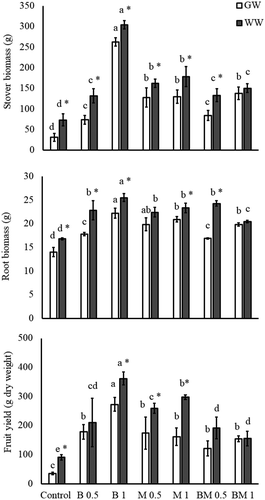Figures & data
Table 1. Electrical conductivity (EC), pH, organic matter, phosphorus (P), lead (Pb), copper (Cu), zinc (Zn), nickel (Ni) and chromium (Cr)
Table 2. Three-way ANOVA results for F- and P-values
Figure 1. Stover biomass, root biomass and fruit yield (dry mass) of tomato under groundwater and wastewater irrigation (mean ± SD). Bars with different letters represent a significant difference between treatments under given irrigation treatment (P < 0.05). Bars with * indicate significant differences between groundwater and wastewater irrigation for a given organic amendment treatment (P < 0.05). B: biochar, M: manure, BM: biochar–manure mixture, 0.5: amendment at 0.5 kg m−2, 1: amendment at 1 kg m−2.

Table 3. Concentration (µg g−1) and NUE (calculated as average yield/concentration of a given heavy metal) of Pb, Cu, Zn, Ni and Cr in tomato fruits irrigated with wastewater (n = 1, pool of three samples)
Table 4. pH, mineral nitrogen (N) (mg g−1 soil) and soluble mineral phosphorous (P) (mg g−1 soil) of soil after harvest of tomato plants (mean ± SD)
